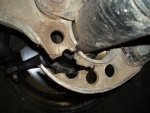ntsqd
Heretic Car Camper
If you're going to quote me, at least quote all of what I said and don't take the part that you want out of context.
There is nothing mechanical done on a vehicle that hasn't already been done on some other mechanical contrivance or some other vehicle. If we can not learn from similar arrangements that did not work or work well, we are doomed. The swivel ball's bolt flange is not something totally unique that only ever exists on that particular design. Slotted holes in that type of assembly, loaded in that fashion, absolutely require some other means to insure the desired orientation. And the bolts are still at risk.
There is nothing mechanical done on a vehicle that hasn't already been done on some other mechanical contrivance or some other vehicle. If we can not learn from similar arrangements that did not work or work well, we are doomed. The swivel ball's bolt flange is not something totally unique that only ever exists on that particular design. Slotted holes in that type of assembly, loaded in that fashion, absolutely require some other means to insure the desired orientation. And the bolts are still at risk.

